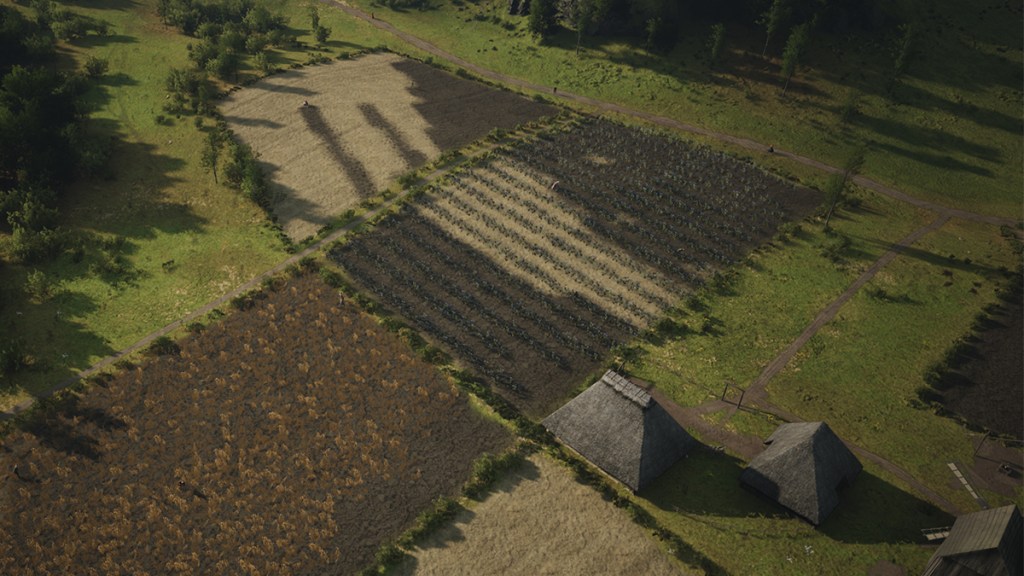Farming is one of the activities you’ll want to jump into as soon as possible in Manor Lords. It will provide the main food source for your digital villagers and will also fuel their ale-filled after-work frivolities.
Manor Lords: Farming Guide
In the beginning of the game, Wheat should be your primary crop because it feeds the townsfolk and could determine whether they survive the first few winters in Manor Lords. There is no harvest during the winter, so you’ll want to ensure there’s a surplus of grain after the harvest in autumn, as well as a Windmill and Communal Oven to churn out bread. Once you’ve got some Wheat stocked up, your next focus in Manor Lords should probably be growing Barley and making ale.

Crop types
- Barley – Used to make Ale
- Flax – Used to make Linen and Clothing
- Rye – Used to make Flour and Bread, more hardy than Wheat and can grow in low fertility areas
- Wheat – Used to make Flour and Bread
Key structures for farming
- Farmhouse – Employs up to eight families for working the fields. They still need Burgage Plots as permanent homes.
- Windmill – Grinds Grain from Wheat or Rye into Flour
- Communal Oven – Converts Flour into Bread
Fertility indicator and crop types

Select the Farming tab in the Construction menu, and a list will appear on the right side of the screen with the following relevant options: Emmer, Flax, Barley, and Rye Fertility. These represent the four types of crops available to plant in Manor Lords. Selecting one will overlay a color-coded land fertility indicator on the map, with bright green representing most fertile and orange/red designating areas to steer clear of.
What is Emmer?
If you’re like me, the term “Emmer Fertility” might lead you to assume there will be a new crop introduced later in the game. However, when laying out fields specifically to grow Wheat, you may also notice that there is no “Wheat Fertility” indicator. That’s because Emmer is an old-timey word for Wheat. It would have been nice if terminology were used consistently in Manor Lords, but then you wouldn’t be learning new vocabulary that you’ll probably never use again.
Soil fertility and crop rotation

In Manor Lords, the fertility of the soil will diminish as it’s used to grow crops, so it’s helpful to enable crop rotation. This will let you schedule each plot’s growing cycle over a three-year period. It’s a good idea to let a field lie fallow for at least one of those years, as this will replenish soil fertility.
The fields are measured in morgen, an old-school unit of land measurement, and a single family in Manor Lords can manage about 2/3 of a morgen per year. When laying out your first farm, a tooltip will advise to make fields 1 morgen, and one plot of wheat of that size should produce enough to feed a small town. But due to diminishing land fertility, you’ll want to have at least three fields: two for growing and one laying fallow or being used for pasture.
Useful Development options for farming

Each time you increase your settlement level by upgrading Burgage Plots, you’ll earn one Development Point. There are four skill trees to invest these points in, and one of them directly benefits farming in Manor Lords.
- Bakeries – Converts Flour into Bread more quickly than a Communal Oven
- Fertilization – Allows you to Fence Up a fallow field, turning it into a pasture and quickly restoring lost fertility
- Heavy Plow – Enables the use of oxen for faster plowing and crop transportation
- Irrigation – Greatly decreases damage from droughts
You may remember illustrations of medieval times with vast farmlands stretching to the horizon just to feed all the people. In Manor Lords, that’s not necessary, though it does look nice. And now that you have a handle on farming in the game, blanketing the land with planted fields will be an aesthetic choice and not a haphazard mistake.








